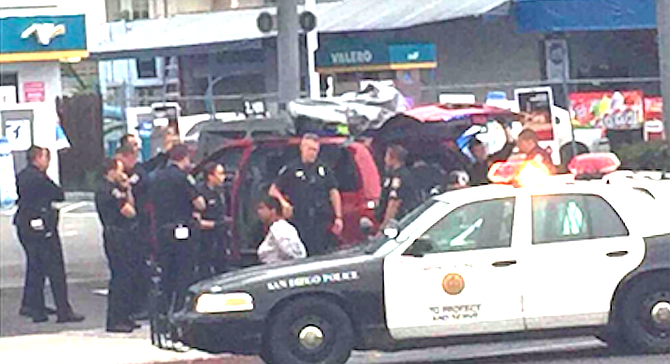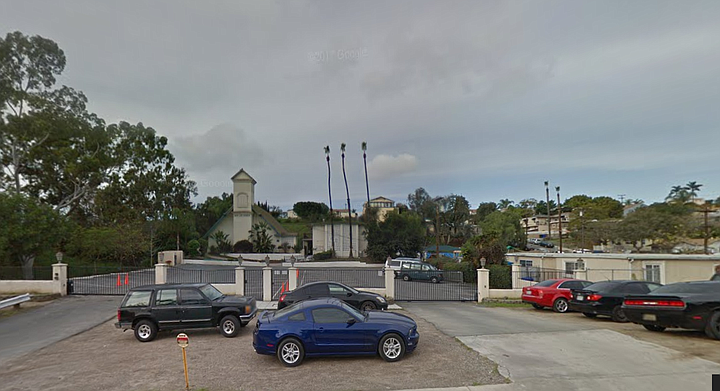 Facebook
Facebook
 X
X
 Instagram
Instagram
 TikTok
TikTok
 Youtube
Youtube

“Hey guys why do you need like 12 squad cars,” asked Konrad Czerwinski to the police officers that blocked off his auto shop.

At approximately 8:00 a.m., on May 5, Czerwinski, the owner of Adams Import on 3166 Adams Ave., was relieved to find out that the majority of police-presence was at his next door neighbor – Valero Corner Store gas station.
“5 cars and a dozen (white male) cops on one black woman?” posted a Normal Heights resident on the NextDoor app. She snapped two photos, uploaded them, and then captioned them: “feeling concerned and afraid to be a witness.”

Her neighbors quickly chimed in.
“The high speed chase went by while I was in my front yard,” said one neighbor, “[and] she did not pull over. One police car was chasing the maroon van with the sirens wailing and lights flashing.”
Others in the neighborhood identified the driver who was arrested as a homeless lady who lives out of her van (another posted that it was a SUV). A few did agree that she parks on the residential streets of Normal Heights.
“It’s [homelessness] a bigger problem here,” Czerwinski said, “and no one’s providing a solution.”
Teresa Smith from Dreams for Change provides a temporary fix for a select few that live inside their vehicles.
“We are the only organization [in San Diego] with a program that specifically address this population,” Smith said.
“One of the biggest challenges facing people who live in their vehicles is finding a dependable and safe place to park at night,” says Smith’s website. “The city of San Diego and surrounding communities have strict laws regulating overnight parking on city streets which limits the available options.”
John lived out of his high-end German car for the past four years. He’s got tinted windows and puts up the sunshade when he crashes out in the middle-class neighborhoods. “They (the police) can get you for illegal camping,” John said, “I’ve only received warnings though.” He added that he doesn’t always park in the same areas, he parallel parks on residential streets with rows of cars, and “it helps that I drive a German car (to avoid suspicion) ” he said. He said he’s seen another homeless guy live out of a Range Rover.
John admitted that vehicle-dwellers “get sweated all of the time … they (the police) bully and intimidate us – when we just want to sleep.”
Smith said that the homeless individuals that live out of their vehicles are different. “We find that 65-70 percent of our clients have some sort of income,” she said, “[and] many have jobs or are in some type of school.”
She said that most do not have major mental health or addiction issues.
John does not do drugs or alcohol and wants to stay “low-key and off-the-radar.” He maintains his car and frugal lifestyle with “legit sporadic gigs” and makes sure that his ride’s clean on the outside and inside in case the San Diego Police Department shine their spotlights on his car. He showers at the “homies” pad, and chills at the library to read or surf the web.
One site that John checks out is Vice, which posted a story in 2016 called “Living Out of a Van Is the New American Dream.” The article is about millennial van-dwellers (some educated) that live like nomads out of their vans.
“We do see college students in our program,” Smith said, “[and] typically, they are within the community college system or private (for-profit) type schools. Students we see that are with the larger universities, we stress upon them to reach out to the schools for assistance.”
Smith’s organization has two locations that can house up to 75 vehicles. One spot is the New Life Church at 766 28th St. (28th and F streets in Golden Hill) and the other is at Jewish Family Services at 8804 Balboa Ave. (two blocks east of the 163 in Kearny Mesa).
The organization’s family advocates create a plan with each participant that places an emphasis on permanent housing solutions, employment, training, emergency support, asset stabilization and asset building.
“One thing different about our participants and shelter homeless is many of our participants have pets, making shelters not an option,” Smith said, “[the] main requirement is a willingness to move back into housing.”
John said that he’s cool with where he’s at now; living in plain sight.
The van-dwelling lady who got caught at Valero’s had “[license plate] tags [that] expired,” according to one of the neighbors.
An inquiry was made to the SDPD regarding the legalities of sleeping in a vehicle in San Diego but no response was made as of press time.
There is a proposed bill before the California legislature, AB 718, which reads: "This bill would prohibit the legislative body of a city, county, or city and county from prohibiting or otherwise subjecting to civil or criminal penalties, or removing or impounding a motor vehicle by reason of, the act of sleeping or resting in a lawfully parked motor vehicle."


“Hey guys why do you need like 12 squad cars,” asked Konrad Czerwinski to the police officers that blocked off his auto shop.

At approximately 8:00 a.m., on May 5, Czerwinski, the owner of Adams Import on 3166 Adams Ave., was relieved to find out that the majority of police-presence was at his next door neighbor – Valero Corner Store gas station.
“5 cars and a dozen (white male) cops on one black woman?” posted a Normal Heights resident on the NextDoor app. She snapped two photos, uploaded them, and then captioned them: “feeling concerned and afraid to be a witness.”

Her neighbors quickly chimed in.
“The high speed chase went by while I was in my front yard,” said one neighbor, “[and] she did not pull over. One police car was chasing the maroon van with the sirens wailing and lights flashing.”
Others in the neighborhood identified the driver who was arrested as a homeless lady who lives out of her van (another posted that it was a SUV). A few did agree that she parks on the residential streets of Normal Heights.
“It’s [homelessness] a bigger problem here,” Czerwinski said, “and no one’s providing a solution.”
Teresa Smith from Dreams for Change provides a temporary fix for a select few that live inside their vehicles.
“We are the only organization [in San Diego] with a program that specifically address this population,” Smith said.
“One of the biggest challenges facing people who live in their vehicles is finding a dependable and safe place to park at night,” says Smith’s website. “The city of San Diego and surrounding communities have strict laws regulating overnight parking on city streets which limits the available options.”
John lived out of his high-end German car for the past four years. He’s got tinted windows and puts up the sunshade when he crashes out in the middle-class neighborhoods. “They (the police) can get you for illegal camping,” John said, “I’ve only received warnings though.” He added that he doesn’t always park in the same areas, he parallel parks on residential streets with rows of cars, and “it helps that I drive a German car (to avoid suspicion) ” he said. He said he’s seen another homeless guy live out of a Range Rover.
John admitted that vehicle-dwellers “get sweated all of the time … they (the police) bully and intimidate us – when we just want to sleep.”
Smith said that the homeless individuals that live out of their vehicles are different. “We find that 65-70 percent of our clients have some sort of income,” she said, “[and] many have jobs or are in some type of school.”
She said that most do not have major mental health or addiction issues.
John does not do drugs or alcohol and wants to stay “low-key and off-the-radar.” He maintains his car and frugal lifestyle with “legit sporadic gigs” and makes sure that his ride’s clean on the outside and inside in case the San Diego Police Department shine their spotlights on his car. He showers at the “homies” pad, and chills at the library to read or surf the web.
One site that John checks out is Vice, which posted a story in 2016 called “Living Out of a Van Is the New American Dream.” The article is about millennial van-dwellers (some educated) that live like nomads out of their vans.
“We do see college students in our program,” Smith said, “[and] typically, they are within the community college system or private (for-profit) type schools. Students we see that are with the larger universities, we stress upon them to reach out to the schools for assistance.”
Smith’s organization has two locations that can house up to 75 vehicles. One spot is the New Life Church at 766 28th St. (28th and F streets in Golden Hill) and the other is at Jewish Family Services at 8804 Balboa Ave. (two blocks east of the 163 in Kearny Mesa).
The organization’s family advocates create a plan with each participant that places an emphasis on permanent housing solutions, employment, training, emergency support, asset stabilization and asset building.
“One thing different about our participants and shelter homeless is many of our participants have pets, making shelters not an option,” Smith said, “[the] main requirement is a willingness to move back into housing.”
John said that he’s cool with where he’s at now; living in plain sight.
The van-dwelling lady who got caught at Valero’s had “[license plate] tags [that] expired,” according to one of the neighbors.
An inquiry was made to the SDPD regarding the legalities of sleeping in a vehicle in San Diego but no response was made as of press time.
There is a proposed bill before the California legislature, AB 718, which reads: "This bill would prohibit the legislative body of a city, county, or city and county from prohibiting or otherwise subjecting to civil or criminal penalties, or removing or impounding a motor vehicle by reason of, the act of sleeping or resting in a lawfully parked motor vehicle."
Comments